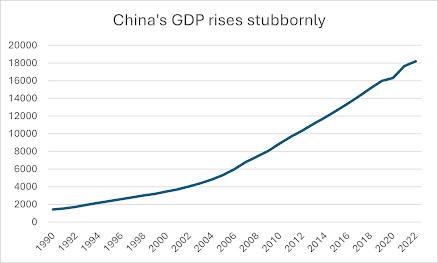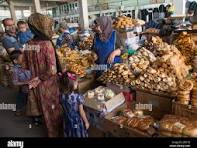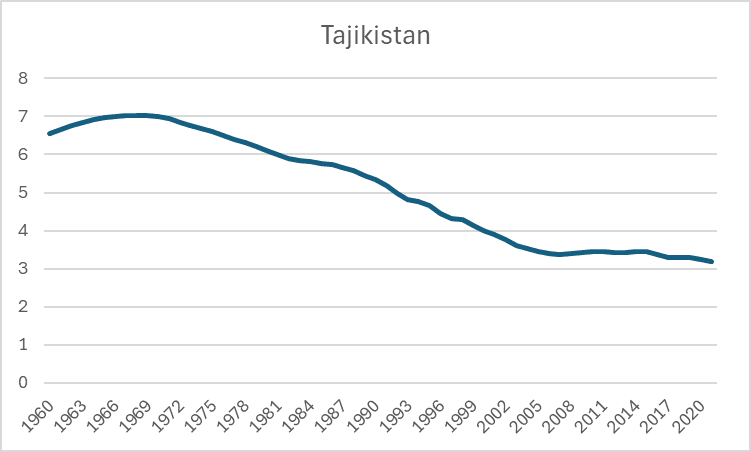Chinese shoppers, look for the blue-light special. Photo: CTGN
In a few decades, China rose from the ranks of the
poorest to the affluent. Its economy burgeoned ninefold from 1990 to 2022 (see
Figure 1). One reason for this economic miracle is that the Chinese save like
prophets. Firms and governments borrow
these abundant funds to build roads, dams, and factories. This expands China’s
capacity to produce and thus its income. China adds far more value in
manufacturing, as a share of its economy, than the typical country; see Figure
2.
Adjusting for inflation and changes in exchange rates,
China has been the world’s largest economy since 2014. Yes, I know that you hear from the news media
that the US is still the largest economy. American reporters are economic
illiterates, led astray by fluctuations in the exchange rate of renminbi per
dollar. These fluctuations have more to
do with temporary rises and falls in money supply than with an economy’s long-run
ability to produce.
Figure 1. China’s gross domestic product, 1990-2022,
in 2017 international dollars.
Figure 2. Manufacturing value added, as a share of
GDP, in China and the world, 2004-2021.
Just how much does China save? Over the long run, the
typical Chinese spends just 55 cents of every international dollar earned; see
Table 1. She saves the other 45 cents, either voluntarily or as tax payments,
which are forced savings. In contrast, Americans spend more than four-fifths of
an additional international dollar. You
would think that since Americans are richer than Chinese, they would save more
of another dollar, because they have already met their essential needs. But
that’s not the case. The Chinese save even more than Kazakhstanis.
(An “international dollar” is an artificial currency
that expresses the cost everywhere of buying a good that would cost a dollar in
the United States. By controlling for changes in the exchange rate, it
expresses the same purchasing power everywhere. We thus avoid the mistake of
thinking that an economy has grown in productive capacity merely because its exchange
rate has strengthened for a few months.)
Table 1. China’s long-run consumption function, 1995-2022
|
R
Square |
1.000 |
|||||
|
Adjusted
R Square |
1.000 |
|||||
|
Standard
Error |
1E+11 |
|||||
|
Observations |
28 |
|||||
|
ANOVA |
||||||
|
|
Df |
SS |
MS |
F |
Significance F |
|
|
Regression |
1 |
1.81E+26 |
1.81E+26 |
17956.18 |
0.00 |
|
|
Residual |
26 |
2.62E+23 |
1.01E+22 |
|||
|
Total |
27 |
1.81E+26 |
|
|
|
|
|
|
Coefficients |
Standard Error |
t Stat |
P-value |
Lower 95% |
Upper 95% |
|
Intercept |
-6.6E+10 |
3.61E+10 |
-1.84 |
0.078 |
-1.4E+11 |
7.9E+09 |
|
GDP |
0.547 |
0.004 |
134.0007 |
1.87E-38 |
0.539 |
0.555 |
Why do the Chinese save so much? Asians in general
save in spades, but that hound don’t really hunt. It explains nothing.
Maybe couples must save to raise those famously large
families. In the 1960s, a Chinese woman
averaged more than seven births. That
was almost triple the number needed to keep the population from declining; see
Figure 3.
But the fertility rate has been falling for decades. This is thanks largely to China’s draconian
policy in the 1970s to allow a couple to raise only one child, to defuse the
then-dreaded Population Bomb. China today might like to have that Bomb back.
Its population has just stabilized at 1.4 billion, and forecasts say it will
even shrink; see Figure 4. In any event, Chinese families are getting smaller,
so they don’t need bigger nest eggs.
Figure 3. The fertility rate in China, 1960-2021.
Figure 4. China’s population, 1960-2022.
Again: Why do the Chinese save? Maybe it’s to pay the taxes of a government that has been a Leviathan for centuries. People have gotten into the (forced) habit of saving for the rainy day, in a country where the government seems to rain every day. But even this explanation falls short, because China has been taxing lightly for at least two decades. The ratio of tax revenues to GDP is only about 8%; see Figure 5. The world average is almost double that. So why haven’t the Chinese loosened their belts in response to softer taxes? Maybe spending habits are hard to change. Which, of course, just begs the question.
Figure 5. Share of tax revenues in GDP, 2005-2021.
In the short run – up to a year – the Chinese spend slightly more of an international dollar than in the long run, probably out of necessity; see Table 2. But over time, they cut spending by 23 billion international dollars, when controlling for income. The Chinese indeed have a passion to save.
Table 2. Short-run
marginal propensity to consume in China, 1995-2022
|
R
Square |
1.00 |
|||||
|
Adjusted
R Square |
1.00 |
|||||
|
Standard
Error |
9.51E+10 |
|||||
|
Observations |
28 |
|||||
|
ANOVA |
||||||
|
|
df |
SS |
MS |
F |
Significance F |
|
|
Regression |
2 |
1.81E+26 |
9.03E+25 |
9985.716 |
0.00 |
|
|
Residual |
25 |
2.26E+23 |
9.05E+21 |
|||
|
Total |
27 |
1.81E+26 |
|
|
|
|
|
|
Coefficients |
Standard Error |
t Stat |
P-value |
Lower 95% |
Upper 95% |
|
Intercept |
-2.8E+10 |
3.93E+10 |
-0.716 |
0.481 |
-1.1E+11 |
5.28E+10 |
|
GDP |
0.586 |
0.020 |
28.982 |
0.00 |
0.545 |
0.628 |
|
Time |
-2.3E+10 |
1.16E+10 |
-1.978 |
0.059 |
-4.7E+10 |
9.48E+08 |
This is not always fortuitous. Central Asia would
certainly prefer that the Chinese buy more imports. And the Chinese themselves
may suffer from their frugality. For when the world economy slows, the Chinese
must provide their own fuel to crank up their GDP engine. If they balk at spending,
recovery may slow. In fact, at a hypothetical income of zero, there is no
evidence that the Chinese would spend anything (see Table 2), even though they could
probably borrow from future taxpayers by selling bonds to be paid off by hiking
future taxes. The Chinese puzzle lives on. – Leon Taylor, Baltimore, tayloralmaty@gmail.com
Notes
For useful comments, I thank but do not implicate
Annabel Benson and Mark Kennet. All data are from the World Development Indicators of the World
Bank, worldbank.org
The data in the tables are from the World Bank’s World Development Indicators for 1993 through 2022. GDP is gross domestic product. Time gives the number of years that have passed since 1990, where Time = 1 for 1990. Consumption is personal consumption expenditures. GDP and Consumption are expressed in 2017 and 2015 international dollars, using purchasing power parity.












